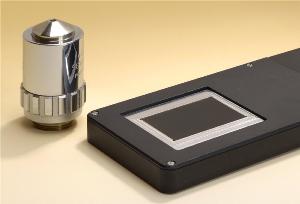Scientists at the Fraunhofer Institute’s Applied Optics and Precision Engineering IOF located in Jena have developed a lightweight, flat microscope that analyses to a resolution of 5 µm.
The Group Manager at IOF, Dr. Frank Wippermann, commented that the new microscope could analyze huge fields. Its 5 µm resolution is comparable with a scanner, he added. It is ultra flat as it has only 5.3 mm of optical length, he said.
 Ultrathin microscope
Ultrathin microscope
Wippermann further said that the ultra-slim microscope comprises multiple compact imaging channels with numerous compact lenses arranged adjacently. Every image channel captures a small portion of the object at the similar size for a 1:1 image, he explained.
Every segment has an approximate size of 300 x 300 µm² and it fixes flawlessly with the adjacent segment. All these segments are assembled by a software to produce a complete image. Concurrent recording of all of the image segments by this technology makes it different from a scanner microscope.
The imaging system comprises three glass plates on which the compact lenses are fixed on their each side. These plates are then arranged on top of each other. Each image channel comprises two achromatic lenses; thus the light is transmitted via eight lenses in total.
The researchers employ various steps to fix the lenses on to the glass substrates. First a photoresistant emulsion is coated over the glass plates and then the plates are exposed to ultraviolet light, resulting in hardening of the plates. While placing the plates in a unique solution, only compact photoresist cylinders stay on the plate surface, while the remaining of the coating is dissolved in the solution. Then, the glass plates are heated to melt the cylinders to produce spherical lenses. The researchers produce an inverse tool as a die based on this master tool.
The resulting die can be utilized for the volume production of the lenses. The die is pressed against a glass substrate coated with a liquid polymer and the resulting polymer layer is then exposed to ultraviolet light. The polymer is then hardened with the shape imprinted by the die, resulting in the production of compact lenses on the glass substrate.
Wippermann said that by using this method, the compact lenses can be mass-produced economically. The scientists will display their first prototype at the LASER World of PHOTONICS trade fair to be conducted from 23 to 26 May 2011 in Munich. The microscope with a picture size of 36 x 24 mm² can capture images of objects with a matchbox size in one attempt. The researchers expect the mass production of the new device within one or two years.